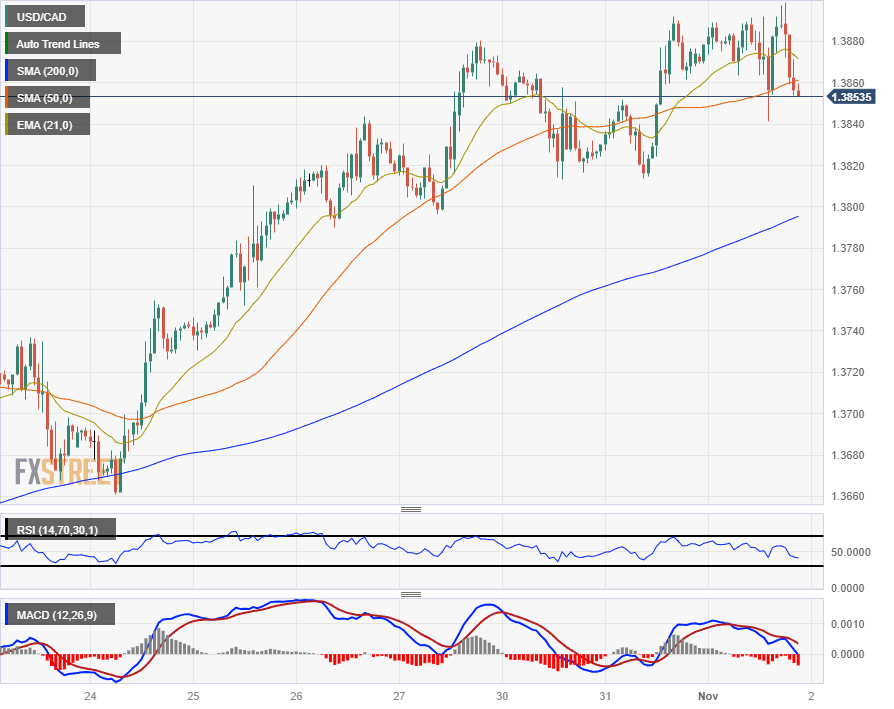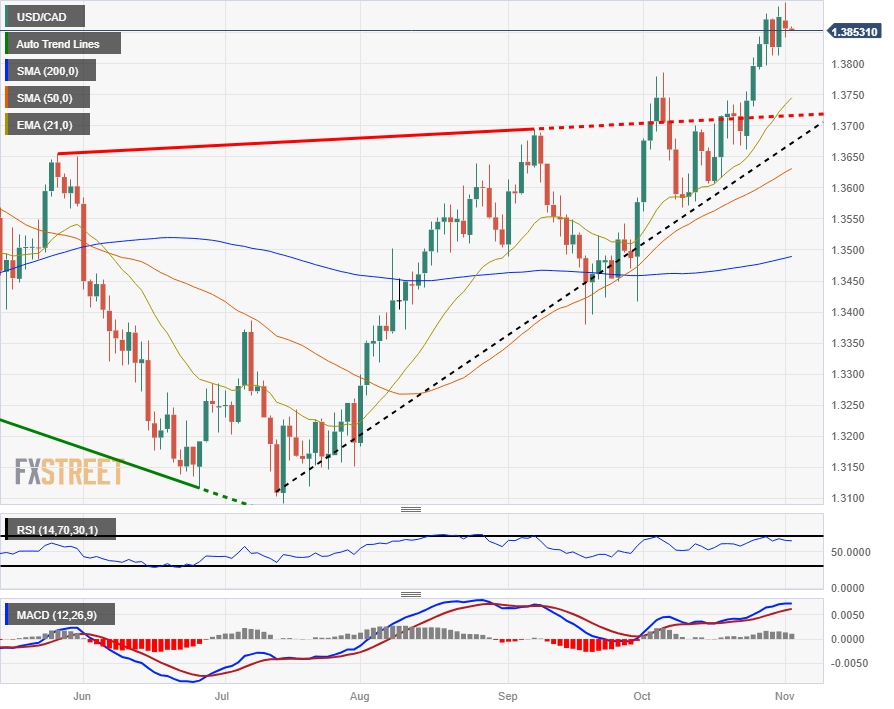- The Canadian Dollar is trapped near familiar low bids as Fed stands pat, as expected.
- Bank of Canada Governor Tiff Macklem wrapping up government testimony today.
- Markets are expecting a hawkish tone from Fed Chair Powell.
The Canadian Dollar (CAD) is stuck to the floorboards with only a minor gain for Wednesday, trading into twelve-month lows as the markets turn to hear Federal Reserve (Fed) Chairman Jerome Powell following the latest rate call from the Fed that sees rates held steady at 5.25-5.5% for the central bank’s November meeting.
Bank of Canada (BoC) Governor Tiff Macklem will be making an appearance later in the day to wrap up day two of his financial conditions testimony to the Canadian government’s Standing Senate Committee on Banking, Commerce and the Economy.
Daily Digest Market Movers: Canadian Dollar held down as markets await Fed’s Powell
- The CAD is stuck at twelve-month lows as Fed holds rates.
- Fed press conference scheduled for 30 minutes after rate release.
- “Hawkish hold” from Fed Chair Powell expected, investors bracing for one last rate hike in December.
- Crude Oil prices have receded, sapping knock-on support for the Loonie.
- BoC Governor Tiff Macklem will be wrapping up his government testimony on financial conditions later in the day.
- Macklem to be followed by Senior Deputy Governor Carolyn Rogers.
- Post-Fed markets will be turning immediately toward Friday’s US Non-Farm Payrolls.
- Canada Unemployment Rate, Employment Change for October also slated for Friday.
Technical Analysis: Canadian Dollar finding little momentum as investors prioritize Fed
The Canadian Dollar (CAD) is cycling just below the 1.3900 handle against the US Dollar (USD) following the Fed’s rate call, and the pair has struggled to etch in any meaningful chart movement since first tapping into 1.3880 last Friday. The Loonie is currently seeing meager gains heading into Thursday, testing the 1.3850 level.
The USD/CAD has been rising since bouncing from the 200-hour Simple Moving Average (SMA) last week near 1.3680, gaining 1.5% as the Loonie recedes against the Greenback. The pair has been finding consistent technical support from the 50-hour SMA as median bids trend upward, with the moving average buoying prices for Wednesday from 1.3860.
On the daily candlesticks, the USD/CAD is firmly pinned into bull territory, trading into year-long highs and catching bullish bounces from the 21-day Exponential Moving Average (EMA).
The floor on bearish corrections will be at the 200-day SMA near 1.3500, with technical support from the 50-day SMA currently pushing upward to 1.3650.
USD/CAD Hourly Chart

USD/CAD Daily Chart

US Dollar price today
The table below shows the percentage change of US Dollar (USD) against listed major currencies today. US Dollar was the strongest against the .
| USD | EUR | GBP | CAD | AUD | JPY | NZD | CHF | |
| USD | 0.08% | 0.00% | -0.17% | -0.90% | -0.25% | -0.70% | -0.24% | |
| EUR | -0.10% | -0.09% | -0.25% | -1.00% | -0.36% | -0.82% | -0.32% | |
| GBP | 0.01% | 0.09% | -0.16% | -0.91% | -0.27% | -0.73% | -0.22% | |
| CAD | 0.17% | 0.26% | 0.18% | -0.73% | -0.07% | -0.54% | -0.07% | |
| AUD | 0.90% | 0.98% | 0.90% | 0.71% | 0.64% | 0.19% | 0.66% | |
| JPY | 0.25% | 0.31% | 0.26% | 0.11% | -0.65% | -0.49% | 0.05% | |
| NZD | 0.71% | 0.81% | 0.72% | 0.57% | -0.18% | 0.47% | 0.49% | |
| CHF | 0.23% | 0.32% | 0.24% | 0.06% | -0.67% | -0.05% | -0.48% |
The heat map shows percentage changes of major currencies against each other. The base currency is picked from the left column, while the quote currency is picked from the top row. For example, if you pick the Euro from the left column and move along the horizontal line to the Japanese Yen, the percentage change displayed in the box will represent EUR (base)/JPY (quote).
Canadian Dollar FAQs
The key factors driving the Canadian Dollar (CAD) are the level of interest rates set by the Bank of Canada (BoC), the price of Oil, Canada’s largest export, the health of its economy, inflation and the Trade Balance, which is the difference between the value of Canada’s exports versus its imports. Other factors include market sentiment – whether investors are taking on more risky assets (risk-on) or seeking safe-havens (risk-off) – with risk-on being CAD-positive. As its largest trading partner, the health of the US economy is also a key factor influencing the Canadian Dollar.
The Bank of Canada (BoC) has a significant influence on the Canadian Dollar by setting the level of interest rates that banks can lend to one another. This influences the level of interest rates for everyone. The main goal of the BoC is to maintain inflation at 1-3% by adjusting interest rates up or down. Relatively higher interest rates tend to be positive for the CAD. The Bank of Canada can also use quantitative easing and tightening to influence credit conditions, with the former CAD-negative and the latter CAD-positive.
The price of Oil is a key factor impacting the value of the Canadian Dollar. Petroleum is Canada’s biggest export, so Oil price tends to have an immediate impact on the CAD value. Generally, if Oil price rises CAD also goes up, as aggregate demand for the currency increases. The opposite is the case if the price of Oil falls. Higher Oil prices also tend to result in a greater likelihood of a positive Trade Balance, which is also supportive of the CAD.
While inflation had always traditionally been thought of as a negative factor for a currency since it lowers the value of money, the opposite has actually been the case in modern times with the relaxation of cross-border capital controls. Higher inflation tends to lead central banks to put up interest rates which attracts more capital inflows from global investors seeking a lucrative place to keep their money. This increases demand for the local currency, which in Canada’s case is the Canadian Dollar.
Macroeconomic data releases gauge the health of the economy and can have an impact on the Canadian Dollar. Indicators such as GDP, Manufacturing and Services PMIs, employment, and consumer sentiment surveys can all influence the direction of the CAD. A strong economy is good for the Canadian Dollar. Not only does it attract more foreign investment but it may encourage the Bank of Canada to put up interest rates, leading to a stronger currency. If economic data is weak, however, the CAD is likely to fall.
Source: https://www.fxstreet.com/news/canadian-dollar-pinned-to-low-side-ahead-of-fed-rate-call-202311011640